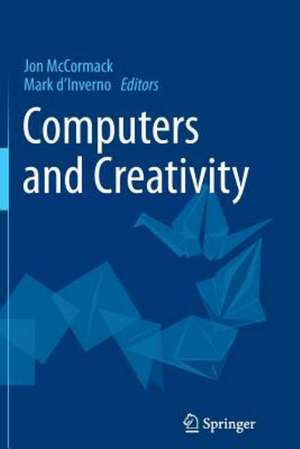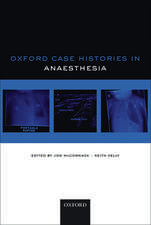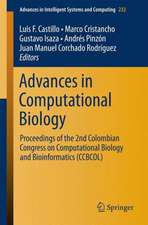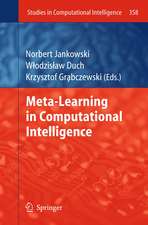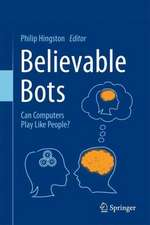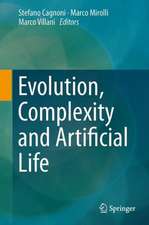Computers and Creativity
Editat de Jon McCormack, Mark d’Invernoen Limba Engleză Paperback – 20 sep 2014
The book tackles critical philosophical questions and discusses the major issues raised by computational creativity, including: whether a computer can exhibit creativity independently of its creator; what kinds of creativity are possible in light of our knowledge from computational simulation, artificial intelligence, evolutionary theory and information theory; and whether we can begin to automate the evaluation of aesthetics and creativity in silico. These important, often controversial questions are contextualised by current thinking in computational creative arts practice. Leading artistic practitioners discuss their approaches to working creatively with computational systems in a diverse array of media, including music, sound art, visual art, and interactivity.
The volume also includes a comprehensive review of computational aesthetic evaluation and judgement research, alongside discussion and insights from pioneering artists working with computation as a creative medium over the last fifty years. A distinguishing feature of this volume is that it explains and grounds new theoretical ideas on creativity through practical applications and creative practice.
Computers and Creativity will appeal to theorists, researchers in artificial intelligence, generative and evolutionary computing, practicing artists and musicians, students and any reader generally interested in understanding how computerscan impact upon creativity. It bridges concepts from computer science, psychology, neuroscience, visual art, music and philosophy in an accessible way, illustrating how computers are fundamentally changing what we can imagine and create, and how we might shape the creativity of the future.
Computers and Creativity will appeal to theorists, researchers in artificial intelligence, generative and evolutionary computing, practicing artists and musicians, students and any reader generally interested in understanding how computers can impact upon creativity. It bridges concepts from computer science, psychology, neuroscience, visual art, music and philosophy in an accessible way, illustrating how computers are fundamentally changing what we can imagine and create, and how we might shape the creativity of the future.
| Toate formatele și edițiile | Preț | Express |
|---|---|---|
| Paperback (1) | 761.60 lei 6-8 săpt. | |
| Springer Berlin, Heidelberg – 20 sep 2014 | 761.60 lei 6-8 săpt. | |
| Hardback (1) | 714.74 lei 6-8 săpt. | |
| Springer Berlin, Heidelberg – 21 aug 2012 | 714.74 lei 6-8 săpt. |
Preț: 761.60 lei
Preț vechi: 951.99 lei
-20% Nou
Puncte Express: 1142
Preț estimativ în valută:
145.75€ • 151.60$ • 120.33£
145.75€ • 151.60$ • 120.33£
Carte tipărită la comandă
Livrare economică 14-28 aprilie
Preluare comenzi: 021 569.72.76
Specificații
ISBN-13: 9783642433290
ISBN-10: 3642433294
Pagini: 456
Ilustrații: XXIV, 432 p.
Dimensiuni: 155 x 235 x 24 mm
Greutate: 0.64 kg
Ediția:2012
Editura: Springer Berlin, Heidelberg
Colecția Springer
Locul publicării:Berlin, Heidelberg, Germany
ISBN-10: 3642433294
Pagini: 456
Ilustrații: XXIV, 432 p.
Dimensiuni: 155 x 235 x 24 mm
Greutate: 0.64 kg
Ediția:2012
Editura: Springer Berlin, Heidelberg
Colecția Springer
Locul publicării:Berlin, Heidelberg, Germany
Public țintă
ResearchCuprins
Part I Art.- Chap. 1 The Painting Fool: Stories from Building an Automated Painter (Simon Colton).- Chap. 2 Creative Ecosystems (Jon McCormack).- Chap. 3 Construction and Intuition: Creativity in Early Computer Art (Frieder Nake).- Chap. 4 Evaluation of Creative Aesthetics (Harold Cohen, Frieder Nake, David C. Brown, Paul Brown, Philip Galanter, Jon McCormack, Mark d’Inverno).- Part II Music.- Chap. 5 Musical Virtuosity and Creativity (François Pachet).- Chap. 6 Live Algorithms: Towards Autonomous Computer Improvisers (Tim Blackwell, Oliver Bown, Michael Young).- Chap. 7 The Extended Composer (Daniel Jones, Andrew R. Brown, Mark d’Inverno).- Chap. 8 Between Material and Ideas: A Process-Based Spatial Model of Artistic Creativity (Palle Dahlstedt).- Chap. 9 Computer Programming in the Creative Arts (Alex McLean, Geraint Wiggins).- Part III Theory.- Chap. 10 Computational Aesthetic Evaluation: Past and Future (Philip Galanter).- Chap. 11Computing Aesthetics with Image Judgment Systems (Juan Romero, Penousal Machado, Adrian Carballal, João Correia).- Chap. 12 Creativity Redefined: Bypassing the Gatekeepers of Appropriateness and Value (Alan Dorin, Kevin B. Korb).- Chap. 13 A Formal Theory of Creativity to Model the Creation of Art (Jürgen Schmidhuber).- Chap. 14 Generative and Adaptive Creativity: A Unified Approach to Creativity in Nature, Humans and Machines (Oliver Bown).- Chap. 15 Creating New Informational Primitives in Minds and Machines (Peter Cariani).- Part IV Epilogue.- Chap. 16 Computers and Creativity: The Road Ahead (Jon McCormack, Mark d’Inverno).
Recenzii
"This book is a brilliant contribution to the literature on creativity in general and the role of computers for fostering and understanding creativity in particular. It presents first a wide range of fascinating projects in the visual arts and music before plunging into theoretical issues concerning the nature of aesthetics and the cognitive processes underlying creativity. Every contribution in this book contains diamonds of novel deep insight, fascinating experiments, and downright good ideas for future work. The cross references and links between the different articles, the added discussion, and the edited conversations between the authors make this book more than the sum of its parts. Computers have already shaken up how art is being conceived, produced and distributed, and this book shows that this evolution can and will go much further than what most people think. It is required reading for everyone involved in the creative arts and interested in the role of technology towards shaping its future." Luc Steels, Professor and Head, Sony Computer Science Laboratories, Paris, France
"A wonderful collection of articles from some of the best in the field. The book fantastically illustrates what an exciting time this is for the interaction between computers and the creative process. Computers are really starting to surprise the people who program them." Marcus du Sautoy, Simonyi Professor for the Public Understanding of Science at the University of Oxford
"Full of information and insights about the creative partnerships between computers, artists and musicians, Computers and Creativity is a timely book that does not shy away from tackling tough questions like where the creativity lies in art made by machines and how improvisation between human and non-human performers can be modelled. Along the way the reader is challenged to rethink assumptions about creativity and question whether a future 'genius' or 'virtuoso' might emerge from code. Thebook will be a valuable resource for anyone interested in the relationship between creativity and computation." Jane Prophet, Professor of Art and Interdisciplinary Computing, City University of Hong Kong
"If I had to pick just one point out of this richly intriguing book, it would be something that the editors stress in their introduction: that these examples of computer art involve creative computing as well as creative art." Margaret A. Boden, OBE, Professor of Cognitive Science, University of Sussex
"This is a challenging, thought provoking, and important book. Challenging because it forces us to confront issues about our relationship with intelligent machines; thought provoking because it asks many difficult questions, some of which do not as yet have answers; and important because it tackles the issues of machine intelligence and artificial creativity in a non-trivial, non-hysterical profound manner. ... Refreshingly there is no techno-messianic hype at all in this book. All chapters are written by leading researchers (25 in all) working at universities, literally at the coalface one might say. This approach leaves no room for flights of science fantasy and ill-founded speculation, which I have found is almost endemic in much of the Extropian style literature regarding human-machine integration. Considering the complexity of the subject matter and its theoretical underpinning, every chapter is extremely well written in a way that makes the book thoroughly accessible to expert and educated layperson alike. ... I thoroughly recommend this book to the widest possible range of practitioners, theorists and students in the field of artificial intelligence related to creativity and the arts." (Rob Harle, February 2013, Leonardo)
"A wonderful collection of articles from some of the best in the field. The book fantastically illustrates what an exciting time this is for the interaction between computers and the creative process. Computers are really starting to surprise the people who program them." Marcus du Sautoy, Simonyi Professor for the Public Understanding of Science at the University of Oxford
"Full of information and insights about the creative partnerships between computers, artists and musicians, Computers and Creativity is a timely book that does not shy away from tackling tough questions like where the creativity lies in art made by machines and how improvisation between human and non-human performers can be modelled. Along the way the reader is challenged to rethink assumptions about creativity and question whether a future 'genius' or 'virtuoso' might emerge from code. Thebook will be a valuable resource for anyone interested in the relationship between creativity and computation." Jane Prophet, Professor of Art and Interdisciplinary Computing, City University of Hong Kong
"If I had to pick just one point out of this richly intriguing book, it would be something that the editors stress in their introduction: that these examples of computer art involve creative computing as well as creative art." Margaret A. Boden, OBE, Professor of Cognitive Science, University of Sussex
"This is a challenging, thought provoking, and important book. Challenging because it forces us to confront issues about our relationship with intelligent machines; thought provoking because it asks many difficult questions, some of which do not as yet have answers; and important because it tackles the issues of machine intelligence and artificial creativity in a non-trivial, non-hysterical profound manner. ... Refreshingly there is no techno-messianic hype at all in this book. All chapters are written by leading researchers (25 in all) working at universities, literally at the coalface one might say. This approach leaves no room for flights of science fantasy and ill-founded speculation, which I have found is almost endemic in much of the Extropian style literature regarding human-machine integration. Considering the complexity of the subject matter and its theoretical underpinning, every chapter is extremely well written in a way that makes the book thoroughly accessible to expert and educated layperson alike. ... I thoroughly recommend this book to the widest possible range of practitioners, theorists and students in the field of artificial intelligence related to creativity and the arts." (Rob Harle, February 2013, Leonardo)
Notă biografică
Jon McCormack is an electronic media artist and researcher in computing. He holds a degree in Applied Mathematics and Computer Science from Monash University, a Graduate Diploma of Art (Film and Television) from Swinburne University and a PhD in Computer Science from Monash University, Melbourne. He is currently Associate Professor in Computer Science, an ARC Australian Research Fellow and director of the Centre for Electronic Media Art (CEMA) at Monash University. His research spans generative art and design, evolutionary systems, creativity, visualisation, interaction, machine learning, L-systems and developmental models. His artworks have been widely exhibited at leading galleries, museums and symposia, including the Museum of Modern Art (New York, USA), Tate Gallery (Liverpool, UK), ACM SIGGRAPH (USA), Prix Ars Electronica (Austria) and the Australian Centre for the Moving Image (Australia). He is the recipient of 16 awards for new media art and research including prizes at Ars Electronica (Austria), Images du Futur (Canada), New Voices, New Visions (USA), Alias/Wavefront (USA), The John Lansdown Award for Interactive Media (Europe/UK), and Nagoya Biennial (Japan).
Mark d’Inverno holds an MA and MSc in Mathematics from Oxford University and a PhD from University College London in Artificial Intelligence. He is Professor of Computer Science at Goldsmiths, University of London and for four years between 2007 and 2011 was head of the Department of Computing which has championed interdisciplinary research and teaching around computers and creativity for nearly a decade. He has published over 100 articles including books, journal and conference articles and led research projects in a diverse range of fields relating to computer science including multi-agent systems, systems biology, art, music and social media. During the final editing of this book he took a research sabbatical shared betweenthe Artificial Intelligence Research Institute and the Sony Computer Science Laboratory in Paris. He is currently the principal investigator or co-investigator on a range of EU and UK projects spanning community building, sharing social experiences, inspiring creativity, cultural engagement and music education. He is a critically acclaimed jazz pianist and composer and over the last 25 years has led a variety of successful bands in a range of different musical genres.
Mark d’Inverno holds an MA and MSc in Mathematics from Oxford University and a PhD from University College London in Artificial Intelligence. He is Professor of Computer Science at Goldsmiths, University of London and for four years between 2007 and 2011 was head of the Department of Computing which has championed interdisciplinary research and teaching around computers and creativity for nearly a decade. He has published over 100 articles including books, journal and conference articles and led research projects in a diverse range of fields relating to computer science including multi-agent systems, systems biology, art, music and social media. During the final editing of this book he took a research sabbatical shared betweenthe Artificial Intelligence Research Institute and the Sony Computer Science Laboratory in Paris. He is currently the principal investigator or co-investigator on a range of EU and UK projects spanning community building, sharing social experiences, inspiring creativity, cultural engagement and music education. He is a critically acclaimed jazz pianist and composer and over the last 25 years has led a variety of successful bands in a range of different musical genres.
Textul de pe ultima copertă
This interdisciplinary volume introduces new theories and ideas on creativity from the perspectives of science and art. Featuring contributions from leading researchers, theorists and artists working in artificial intelligence, generative art, creative computing, music composition, and cybernetics, the book examines the relationship between computation and creativity from both analytic and practical perspectives. Each contributor describes innovative new ways creativity can be understood through, and inspired by, computers.
The book tackles critical philosophical questions and discusses the major issues raised by computational creativity, including: whether a computer can exhibit creativity independently of its creator; what kinds of creativity are possible in light of our knowledge from computational simulation, artificial intelligence, evolutionary theory and information theory; and whether we can begin to automate the evaluation of aesthetics and creativity in silico. These important, often controversial questions are contextualised by current thinking in computational creative arts practice. Leading artistic practitioners discuss their approaches to working creatively with computational systems in a diverse array of media, including music, sound art, visual art, and interactivity.
The volume also includes a comprehensive review of computational aesthetic evaluation and judgement research, alongside discussion and insights from pioneering artists working with computation as a creative medium over the last fifty years. A distinguishing feature of this volume is that it explains and grounds new theoretical ideas on creativity through practical applications and creative practice.
Computers and Creativity will appeal to theorists, researchers in artificial intelligence, generative and evolutionary computing, practicing artists and musicians, students and any reader generally interested in understanding how computers can impactupon creativity. It bridges concepts from computer science, psychology, neuroscience, visual art, music and philosophy in an accessible way, illustrating how computers are fundamentally changing what we can imagine and create, and how we might shape the creativity of the future.
The book tackles critical philosophical questions and discusses the major issues raised by computational creativity, including: whether a computer can exhibit creativity independently of its creator; what kinds of creativity are possible in light of our knowledge from computational simulation, artificial intelligence, evolutionary theory and information theory; and whether we can begin to automate the evaluation of aesthetics and creativity in silico. These important, often controversial questions are contextualised by current thinking in computational creative arts practice. Leading artistic practitioners discuss their approaches to working creatively with computational systems in a diverse array of media, including music, sound art, visual art, and interactivity.
The volume also includes a comprehensive review of computational aesthetic evaluation and judgement research, alongside discussion and insights from pioneering artists working with computation as a creative medium over the last fifty years. A distinguishing feature of this volume is that it explains and grounds new theoretical ideas on creativity through practical applications and creative practice.
Computers and Creativity will appeal to theorists, researchers in artificial intelligence, generative and evolutionary computing, practicing artists and musicians, students and any reader generally interested in understanding how computers can impactupon creativity. It bridges concepts from computer science, psychology, neuroscience, visual art, music and philosophy in an accessible way, illustrating how computers are fundamentally changing what we can imagine and create, and how we might shape the creativity of the future.
Caracteristici
Interdisciplinary volume introduces new theories and ideas on creativity, evolutionary computation and the computational arts Features contributions from some of the world’s leading researchers, theorists and artists Explains and grounds theoretical ideas on creativity with practical applications and current creative practice Includes supplementary material: sn.pub/extras Includes supplementary material: sn.pub/extras
